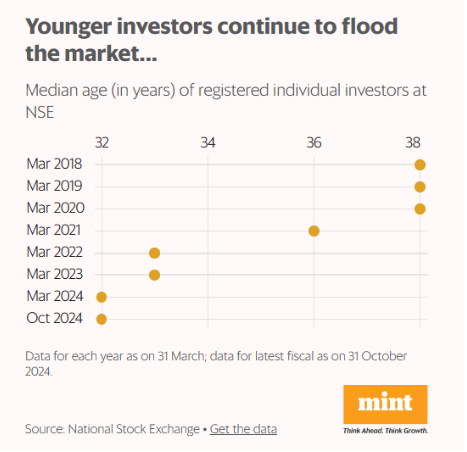
The Changing Demographics of the Indian Stock Market
The Indian stock market is witnessing a significant shift in investor demographics, particularly among individual retail investors. This trend reflects a younger and more dynamic audience entering the market and reshaping its structure.

Younger Investors Are Dominating the Market
In 2018, the median age of investors was 38 years, meaning half the investors were younger and the other half older. This figure remained stable until 2020. However, in recent years, it has steadily declined to 32 years as of 2024. This significant drop highlights the influx of younger investors into the market.
The percentage of investors under the age of 30 has nearly doubled in the last six years, jumping from approximately 22.5% to an impressive 40%. Meanwhile, there has been little change in the number of investors aged 30 to 50. However, older age groups have seen a slight decline in representation as younger participants claim a larger market share.

What’s Driving the Youth Towards Investing?
The increase in younger investors is closely tied to India’s demographic advantage. As more young professionals enter the workforce, they are becoming financially aware and actively investing their earnings. Encouraged by corporate initiatives, financial literacy programs, and the ease of investing through digital platforms, many young Indians are choosing to invest in systematic investment plans (SIPs) and equity markets early in their careers.
SIP contributions, a popular route for mutual fund investments, have surged over the years. This steady inflow of funds reflects the discipline and long-term mindset of these new investors. This growing trend is expected to continue as India’s young workforce expands.
A Resilient New Generation of Investors
There is a notion that these young investors, having never experienced a prolonged bear market, might exit the market during downturns. However, this assumption may be unfounded. The new generation of investors seems to exhibit a more informed and systematic approach, likely due to increased financial education and the availability of robust investment tools.
Even if market corrections of 20–30% occur—natural cycles in any financial market—this segment of investors is likely to remain committed. Extreme downturns, such as the 60–70% crash seen during the 2008 financial crisis, are rare events. Preparing mentally for smaller corrections and using them to accumulate quality stocks can turn such events into opportunities.
India’s stock market is well-positioned for growth with this new generation of investors leading the charge. While market fluctuations are inevitable, the resilience and optimism of these young participants suggest a bright future for India’s financial markets.
WeekendInvesting launches – PortfolioMomentum Report
Momentum Score: See what percentage of your portfolio is in high vs. low momentum stocks, giving you a snapshot of its performance and health.
Weightage Skew: Discover if certain stocks are dominating your portfolio, affecting its performance and risk balance.
Why it matters
Weak momentum stocks can limit your gains, while high momentum stocks improve capital allocation, enhancing your chances of superior performance.
Disclaimers and disclosures : https://tinyurl.com/2763eyaz









